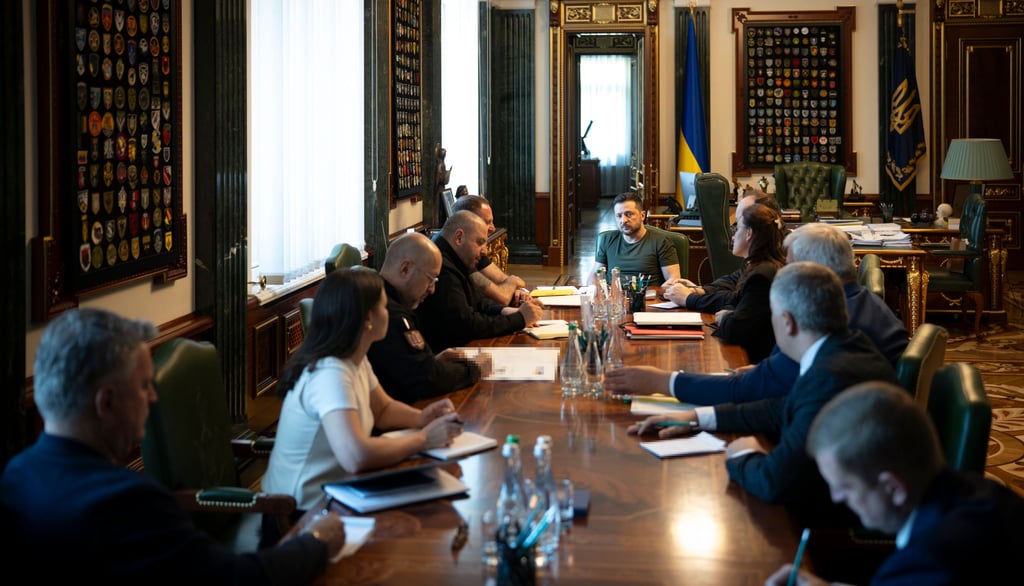Ukraine’s Diplomatic Tightrope: Zelenskyy’s Strategic Pivot Amid Global Pressures
8/17/20254 min read


Ukraine’s Diplomatic Tightrope: Zelenskyy’s Strategic Pivot Amid Global Pressures
Introduction: A Nation at a Crossroads
As the clock ticks toward 3:00 PM PDT on August 16, 2025, the world watches Ukraine navigate a delicate diplomatic tightrope. President Volodymyr Zelenskyy’s recent X post, dated August 15, 2025, reveals a high-stakes meeting with government officials, the Office, and the National Security and Defense Council. The agenda? A revamped foreign policy plan to secure defense funding, audit coalition effectiveness, and strengthen EU ties. This move comes as global leaders, including U.S. President Donald Trump, weigh in with contrasting views, urging negotiation with Russia. Let’s dive into this pivotal moment in U.S. global analysis, exploring how Ukraine’s strategy unfolds against a backdrop of war, international alliances, and domestic unrest.
The Meeting: A Glimpse Into Strategy
Zelenskyy’s post showcases a formal gathering in an ornate room adorned with Ukrainian flags and walls lined with medals—symbols of resilience. The discussion zeroed in on critical issues: funding Ukraine’s Defense Forces, evaluating the efficiency of international coalitions, and shaping bilateral relations with key global players. Notably, Zelenskyy ordered an update to the foreign policy plan by Monday, signaling urgency. This audit of coalition effectiveness is a bold step, rare in wartime diplomacy, suggesting a push for accountability amid reliance on Western support.
The timing is telling. With Europe maintaining robust military aid in May and June 2025 (per the Ukraine Support Tracker), Ukraine’s leadership appears to be ensuring every dollar and weapon counts. The ornate setting isn’t just aesthetic—it’s a strategic nod to national pride, potentially boosting morale for diplomats and soldiers alike. Yet, the question lingers: can this plan bridge the gap between international promises and battlefield realities?
Global Context: Trump’s Summit and U.S. Influence
Enter the U.S. perspective. On August 16, 2025, Trump’s comments from a recent summit echo a familiar refrain: Ukraine should negotiate with Russia due to the power imbalance. This aligns with a 2023 RAND Corporation study, which found prolonged conflicts often favor larger powers like Russia unless countered decisively. Trump’s stance contrasts sharply with Zelenskyy’s refusal to cede Crimea or Donbas, a position rooted in national sovereignty and supported by historical resistance.
The U.S. has been a linchpin in Ukraine’s defense, with significant financial and military aid tracked since 2022. However, Trump’s call for negotiation could signal a shift in American foreign policy, especially if domestic pressures or upcoming elections prioritize de-escalation. For Ukraine, this creates a diplomatic tightrope—balancing U.S. support while resisting concessions that could undermine its territorial integrity. How will Zelenskyy navigate this tension?
Domestic Pulse: X Reactions Reveal a Divide
The X thread following Zelenskyy’s post paints a raw picture of public sentiment. While some, like@taurenoff, offer cautious support (“Good. You need all the help you can get”), others are scathing. @mr_hans64321 accuses the leadership of incompetence, calling for resignations, while@AlinaKharkiv8 quotes a heated video, labeling Zelenskyy unrepresentative of Ukrainian values. Memes like@vladstavrb3’s “We have a plan!” mock the repeated promises of victory plans.
This frustration hints at a disconnect. Despite the polished diplomacy of the meeting, grassroots voices suggest war fatigue and skepticism about leadership effectiveness. The inclusion of the quote from Post 1851576103195869377 (a confrontational image) in @AlinaKharkiv8’s reply amplifies this discontent, linking it to broader critiques of Zelenskyy’s governance. Can this updated plan restore public trust, or will it fuel further division?
Strategic Implications: A High-Stakes Gamble
Zelenskyy’s directive to audit coalitions is a gamble with high rewards and risks. On one hand, it could strengthen Ukraine’s negotiating power by proving its allies’ commitments are effective, aligning with the Kiel Institute’s 2025 data showing increased European defense industry procurement. On the other, it risks alienating partners if audits expose inefficiencies, especially with the U.S. potentially rethinking its role.
The focus on EU-level work also signals a pivot toward European integration, a long-term strategy to counter Russian influence. Yet, with China’s alleged support for Russia (per Zelenskyy’s 2024 claims) complicating the geopolitical chessboard, Ukraine’s diplomatic corps faces a multifaceted challenge. This plan could either solidify Ukraine as a resilient ally or expose vulnerabilities in its international network.
Why This Matters to the U.S. and Global Audience
For the U.S., Ukraine’s fate is a litmus test for its global leadership. Supporting Zelenskyy’s strategy reinforces NATO’s eastern flank, a priority since Russia’s 2022 invasion. However, Trump’s negotiation push reflects a segment of American opinion wary of endless conflict, echoing Obama-era hesitancy on Syria. The outcome could reshape U.S. foreign policy, influencing how it engages with other hotspots like the Middle East or Asia.
Globally, Ukraine’s diplomatic moves offer a case study in resilience. Nations from Europe to Asia watch closely, as the war’s lessons—documented by RAND’s analysis of Chinese military studies—could inform future conflicts. Zelenskyy’s balancing act might inspire smaller states to assert sovereignty, or it could serve as a cautionary tale of overreach.
Conclusion: A Plan in the Balance
As of August 16, 2025, Zelenskyy’s updated foreign policy plan is a beacon of hope and a target of scrutiny. The meeting’s symbolism, the global context, and the domestic backlash weave a complex narrative. Ukraine stands at a crossroads, with its leadership betting on diplomacy to secure its future. Whether this gamble pays off depends on execution, international support, and the ability to heal internal rifts.
This story is far from over. The world waits to see if Monday’s updated plan delivers results—or if it’s another chapter in a war of attrition. For now, Ukraine’s diplomatic tightrope holds, but the stakes couldn’t be higher.
Thought Questions
How might Trump’s negotiation push influence U.S. aid to Ukraine in the coming months?
Can Zelenskyy’s coalition audit strengthen or weaken Ukraine’s international alliances?
What role should public sentiment play in shaping Ukraine’s wartime strategy?
hello@boncopia.com
+13286036419
© 2025. All rights reserved.